Heriz
Heriz Rugs
What is a Heriz Style Rug?
Heriz rugs are easily recognizable because of their bold colors and unique signature design, consisting of a large medallion with oversized corner pieces and double or even triple outlining.
These Persian rugs are also heavier and more durable as compared to most other types of Persian rugs.
Heriz rugs are famous for their durability, thanks to the high-quality wool they’re made from. This type of Persian rug feels heavier and sturdier than most others, which has earned them a reputation for being some of the toughest and longest-lasting rugs you can buy.
Despite their toughness, these rugs are also known for their beauty. They’re a favorite pick among people who love rugs and are always a standout choice.
The rugs are hand-knotted and blend different design elements, both traditional and tribal. This blend shows the many different cultures that have left their mark on the Heriz region.
Heriz carpets are recognized for their geometric patterns and the wide range of colors used in their designs. This variety in design and color is a testament to the high skill level and craftsmanship that goes into each Heriz rug.
Table of Contents
The Story of Heriz Rugs: From Iran to the World
Heriz rugs are special carpets from around Mount Sabalan in Heriz, located in northwestern Iran. This location is important because it gives the rugs their toughness. The water in this area is full of minerals, which helps the sheep grow strong, high-quality wool.
The town of Heriz is only about 60 miles from the city of Tabriz, which is famous for making carpets. This closeness means that the people making rugs in Heriz could learn from the traditions in Tabriz but also create their unique styles.
In the 1800s, many Heriz rugs were made to be sold to Europe and Britain. These rugs show a mix of different cultural styles, a big part of what makes the Heriz area special.
The rugs from Heriz are made by hand and show a balance of Persian and tribal design elements, showing the mix of cultures in the Heriz region.
So, each Heriz rug has its own story – it tells us where it comes from, its history, and the different cultural styles that have shaped its design over time.
Symbolism and Motifs in Heriz Rug Designs
Heriz rugs are celebrated for their bold and intricate designs, often incorporating traditional motifs and symbols. Each element carries deep cultural significance, reflecting the rich history and heritage of the artisans who create these rugs.
Here’s a closer look at some of the most common symbols and motifs you might find in a Heriz rug design:
The Central Medallion
One of the most striking features of many Heriz rugs is the large central medallion, which often contrasts strongly with the surrounding field. This design is thought to have been inspired by the grand domes of mosque architecture. In a broader sense, the medallion can symbolize the concept of unity or the heart of the home.
Botanical Motifs
Flowers and leaves, on the other hand, can symbolize rebirth and the cycle of life. They can also represent the beauty and fragility of nature, reminding us of the importance of preservation and respect for the environment.
Geometric Shapes
Heriz rugs are renowned for their geometric designs. These shapes often have symbolic meanings. For instance, the diamond often symbolizes protection against the evil eye, while the hook (mirroring the shape of a dragon or serpent) can symbolize power and strength.
Animal Motifs
Animal motifs are less common in Heriz rugs but can still be found. They are typically stylized and geometric. Birds often represent happiness and joy, while horses can symbolize power and freedom. The presence of these animals can provide insight into the cultural and natural environment of the rug weavers.
The Border
The border of a Heriz rug often contains symbolic motifs. The most common border designs are a series of small, repeated patterns representing continuity, protection, and the cyclical nature of life.
Understanding these symbols and motifs can add a new appreciation for Heriz rugs. They are not merely decorative pieces but woven narratives and cultural expressions, each carrying its unique set of symbols that tell a story of heritage, beliefs, and the daily life of the weavers.
What Are The Colors of Heriz Rugs?
Heriz rugs owe their warm, rich colors and vibrant hues to natural dyes extracted from plants, minerals, and insects. The warmer tones result from the region’s vegetation which often yields darker dyes.
The Heriz rug makers, in particular, were renowned for their mastery of vegetable dyeing and the abrash technique, which is amply evident in the rich colors used in these rugs.
Heriz carpets typically flaunt a palette of rich reds, deep blues, brilliant greens, and sunny yellows, all beautifully contrasted against a creamy ivory backdrop. A unique attribute is the brilliant teal or turquoise shade of blue, often offset by cream and ivory accents. Over time, the dark shades on these antique rugs gracefully fade, transforming into lighter versions of their original hues.
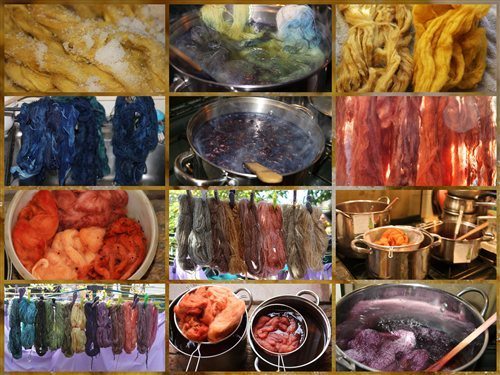
What is The Difference Between Heriz and Serapi?
Antique Heriz rugs, known for oversized medallions and large corner pieces, are a marvel of rug craftsmanship. These rugs often feature angular oak leaves and assorted foliage, all dyed in warm, natural colors that create an inviting aesthetic. The complex motifs of these rugs are set against a skillfully created abrash field, resulting in a bold, eye-catching effect.
Interestingly, only natural dyes were used to produce antique Heriz rugs. Over the years, these dyes tend to mellow, giving the rugs a subtle patina that isn’t seen in newer pieces.
Antique Heriz Rugs
Antique Heriz rugs, known for oversized medallions and large corner pieces, are a marvel of rug craftsmanship.
These rugs often feature angular oak leaves and assorted foliage, all dyed in warm, natural colors that create an inviting aesthetic. The complex motifs of these rugs are set against a skillfully created abrash field, resulting in a bold, eye-catching effect.
Interestingly, only natural dyes were used to produce antique Heriz rugs. Over the years, these dyes tend to mellow, giving the rugs a subtle patina that isn’t seen in newer pieces.
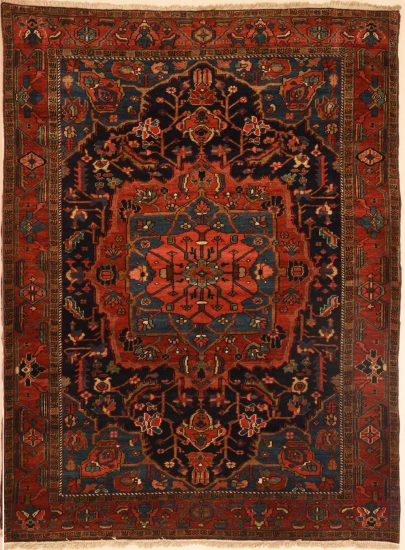
Understanding Serapi Rugs
Serapi rugs, a distinctive type of Heriz rug, carry an intriguing history. They were woven before 1910 and became highly sought-after when their production was discontinued in the 1930s.
To meet the rising demand, rug buyers started using the pseudonym “Serapi” to describe a specific type of Heriz rug.
This term originated from the district of the village of Serab, located in the Heriz region of Iran, where these rugs were woven.
What is The Value of Serapi Rugs?
These rarer rugs often date back to before 1900; they are typically more expensive than Heriz. These older antique rugs are valuable due to their scarcity and historical significance.
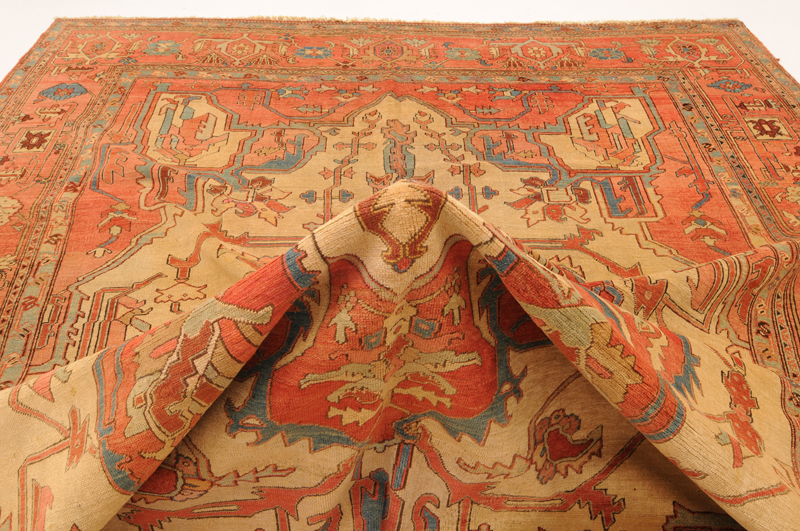
Comparing Antique Heriz Carpets and Serapi Rugs: A Closer Inspection
Although both antique Heriz carpets and Serapi rugs originate from the same geographic region and share some similarities in design, they are distinct entities with unique characteristics. These differences may not be instantly apparent to an untrained eye. A deeper investigation – particularly by inspecting the underside and feeling the texture of the weave – reveals their distinctive traits.
Design and Pattern
The design and pattern of these rugs can offer key clues to their identity. Antique Heriz carpets traditionally showcase a central medallion design that often takes the form of a multi-sided star, typically with more than eight sides. This star is usually encompassed by highly stylized floral motifs that add to the rug’s overall detailed design.
In contrast, Serapi features a central medallion, but the design takes a different turn. The medallion in a Serapi rug is typically outlined in bold lines, thus presenting a visual impact that diverges from the star-shaped Heriz medallion.
Color and Detail
Heriz rugs are known for their darker, richer colors, and their design typically covers the entire surface area in elaborate detail. The depth of color combined with the detailed design creates a visually impactful piece that can be a stunning addition to any space.
On the other hand, Serapi, while intricately detailed, follows a different aesthetic approach. They tend to have more open spaces in their design, allowing the foundational canvas to breathe and be visible. Furthermore, Serapi rugs usually exhibit a lighter color palette, providing a softer visual effect compared to the vibrant and intense colors of Heriz rugs.
By understanding these nuances and distinctions, one can more effectively appreciate and differentiate between the artistry and heritage embedded in antique Heriz carpets and Serapi.
Materials and Construction of Heriz Carpet
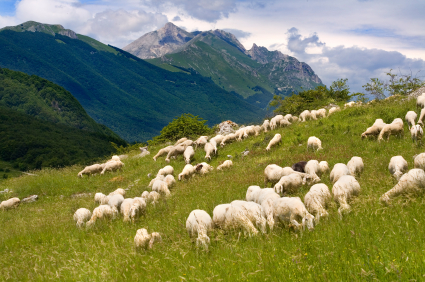
Wool and Cotton
The weavers primarily use high-grade wool for the pile and robust cotton for the foundation or warp and weft.
There is a marked difference between the wool used in antique Heriz carpets and those manufactured in later years. However, despite the change in the type of wool used, weavers do not compromise on the quality of the wool.
Lustrous wool from the Shahsavan tribe was mostly used to create antique Heriz. The Shahsavan was a nomadic tribe that traversed the nearby Elbrus Mountains. The vegetation and climate at those altitudes resulted in high-quality wool found in the antique Heriz rugs.
More recent weavers obtain high-quality, lanolin-rich wool from the sheep reared in the region surrounding Mount Sabalan in northwestern Iran. This region is known for producing exceptionally resilient wool due to the trace amounts of copper found in the drinking water of the sheep, which strengthens the wool.
These environmental factors and careful shearing and processing techniques result in the high-quality wool used in modern Heriz rugs.
Weaving Techniques
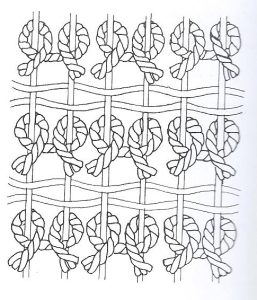
The craftsmanship of Heriz is deeply rooted in Persian rug weaving traditions. Using a variant of the Symmetrical Turkish or Ghiordes knot, weavers create a dense, durable rug pile.
This technique is known for its strength, thereby adding to the hard-wearing nature of Heriz rugs. Each rug is a testament to the skill and artistry of its weaver, with every knot hand-tied to create intricate designs and patterns.
Knot Density and Quality
Heriz rugs have a coarse construction employing a thick, sturdy cotton foundation with tightly packed knots, making for their well-known durability.
The knot count can range from a lower count of 100 knots per square inch to a higher count of about 144 KPSI. Heriz rugs woven with a higher knot count of over 144 knots per square inch are unusual.
While this knot density is lower than other Persian rugs, it does not detract from their quality or durability. Instead, it allows for bold, geometric designs to be displayed more prominently. The quality of a Heriz rug is evident in the knots’ evenness, the patterns’ precision, and the rug’s overall finish.
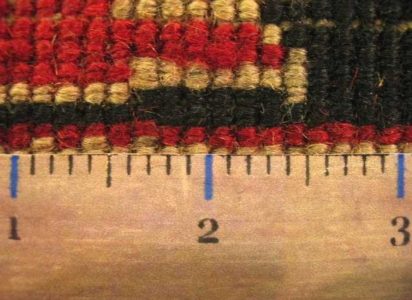
Pile
The pile of Heriz rugs is typically medium to high, adding to the rug’s robustness and durability.
The high pile provides a plush feel underfoot, enhancing the rug’s functional comfort. Despite their thickness, Heriz rugs exhibit impressive clarity of design, with the patterns visible and distinct.
This balance between comfort, durability, and design precision is a hallmark of the Heriz rug’s exceptional construction.
Standard Rug Sizes of Heriz Rugs
Heriz rugs are produced in various sizes to suit different spaces and needs. They range from smaller sizes perfect for foyers and bedside placements to larger sizes that can cover a significant portion of your living or dining room.
Here are the standard sizes you might come across:
Small: 3′ x 5′
Heriz Runner Rug Options
In addition to the standard sizes, Heriz rugs come as runner rugs. Runners are typically narrow and long, making them ideal for hallways, narrow spaces, or alongside a bed or kitchen island. They commonly come in sizes from 2.5′ x 6′ up to 4′ x 17′.
Purchasing Heriz Rugs
When purchasing a Heriz rug, authenticity and quality are paramount. Genuine Heriz rugs are renowned for their durability and craftsmanship, a testament to their rich weaving tradition. Look for hand-knotted rugs with tightly packed knots and made of high-quality wool.
It’s also crucial to examine the rug’s patterns and colors. Authentic Heriz rugs typically feature bold, geometric designs.
Remember, each rug is unique and bears the mark of its weaver. Minor inconsistencies in pattern or color are not a sign of poor quality but rather evidence of a rug’s handmade nature.
The price of a Heriz rug can vary significantly depending on its size, age, condition, and quality of craftsmanship. Generally, larger rugs and those with finer detail and higher knot density command higher prices. Due to their rarity and historical value, an antique Heriz carpet can be more expensive.
When budgeting for a Heriz carpet, consider it as an investment. These rugs are known for their durability and can last for generations if properly cared for.
Whether you’re shopping online or in person, purchase from a reputable dealer who can provide a certificate of authenticity and offers a fair return policy. This will ensure you get a genuine, high-quality Heriz rug that you can enjoy for many years.
How to Use Persian Heriz Rugs in Your Interior Decor
Heriz rugs are an excellent addition to any home decor style. From modern to traditional, these rugs can seamlessly integrate into your space, adding a touch of elegance and warmth.
Traditional Decor: The designs and classic medallions of antique Heriz rugs make it a perfect fit for traditional decor. Place it in a living or dining room with dark wood furniture and rich, opulent fabrics for a timeless look.
Modern Decor: Despite their traditional origins, Heriz rugs can also complement modern decor. The geometric patterns can add an interesting contrast to sleek, minimalist furniture. Opt for Heriz rugs with softer colors for a more subdued look or bold, vibrant colors to make a statement.
Bohemian Decor: The rich, warm colors and exotic patterns of Heriz rugs are a perfect match for a bohemian style. Mix and match with other patterned textiles for an eclectic, global-inspired look.
Placement Ideas
Living Room: A large Heriz rug can anchor a living room, defining the seating area and bringing warmth and color to the space. Ensure the front legs of your sofas and chairs are on the rug to tie the arrangement together.
Dining Room: Heriz carpets in dining rooms create a sense of grandeur and formality. Ensure the rug is large enough so the chairs remain on the rug even when pulled out.
Bedroom: A Heriz rug placed under the bed can add a layer of comfort and luxury. The rug should extend at least 2-3 feet on either side of the bed.
Hallways and Entryways: Heriz runners are perfect for adding a touch of elegance to hallways and entryways. They protect your floors and introduce color and pattern to these often overlooked spaces.
Coordinating Colors with Heriz Persian Rugs
You’ll create a cohesive and pulled-together look by matching the colors in your décor with those in your rug.
For instance, if your rug has a lot of red, pair it with red throw pillows on your sofa to make a cohesive look. If your rug has many warm red tones, they go beautifully with wooden furniture to create an expensive look. If your rug has lots of green and brown, pair it with earth tones like tan or beige.
Remember, the beauty of Heriz rugs lies in their versatility. They can adapt to and enhance virtually any style or space, making them a valuable addition to your home.
How to Care for Heriz Rugs
Buying older antique Heriz rugs is a great investment, and you must care for them properly to maintain their appearance and value. With simple care and maintenance, your Heriz rug can be a family heirloom that will be passed down to family members.
Taking care of a rug is not difficult as long as you keep up with it and take care of it regularly. It is also important to get your rug cleaned professionally once every 5 to 10 years to eliminate any dust that has settled into the rug, even with regular care.
To ensure your Heriz rug is well maintained, you should regularly clean it with a brush or a vacuum cleaner. This can help to minimize dust and dirt buildup.
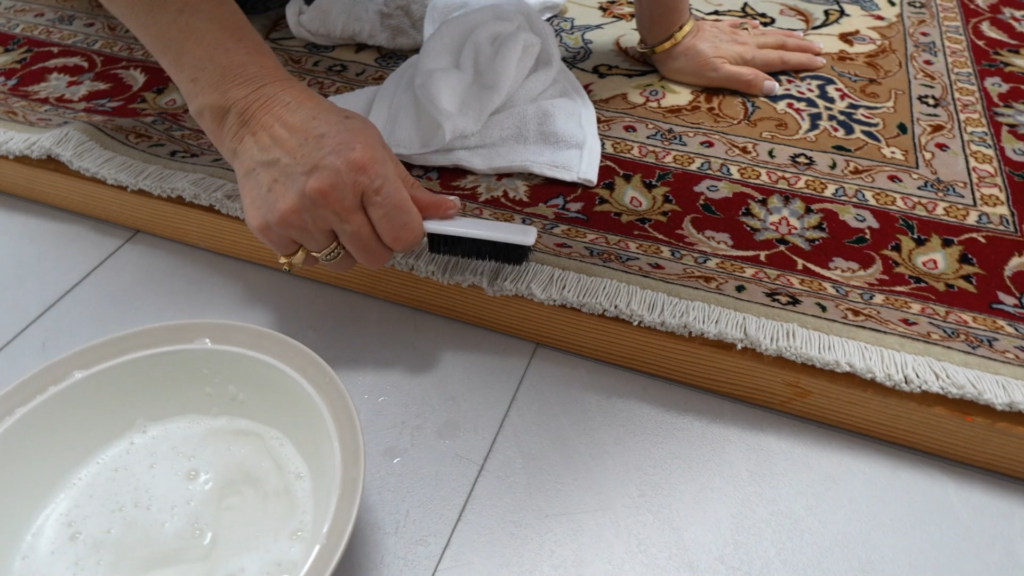
Rotate your rug to minimize uneven sun exposure and ensure that any wear is evenly dispersed instead of concentrated on one rug area. Sun exposure can lead to rug fading, damaging your rug’s appearance. To avoid prolonged sun exposure in direct sunlight, you can use curtains or blinds to shade the rug.
If a spill occurs, act quickly to prevent the stain from setting. Blot the area with a clean, damp cloth, but avoid rubbing, which can spread the stain and damage the fibers. Be sure to blot from outside the stain inwards to prevent the spill from spreading. After cleaning a spill or stain, press dry towels onto the damp area to soak up as much moisture as possible.
Avoid dampening your rug for extended periods, as it can cause mildew or color bleed. Dampness can be a major issue for handmade Heriz rugs as it can lead to shrinking.
Remember, when it comes to cleaning and stain removal, if you’re unsure, it’s best to consult with a professional rug cleaner to prevent damage to your antique Heriz rug.
How to Store Your Heriz Rug
If you need to store your antique Heriz carpets for an extended period, the right steps are crucial to maintaining the rug’s quality and preventing damage.
Clean the Rug Before the Storage
Before storing your Heriz rug, ensure it is thoroughly cleaned. Any dirt or dust left in the rug can cause damage over time, so proper cleaning is vital. Vacuum both sides of the rug to remove surface dirt and dust. For a deeper clean, consider hiring a professional rug cleaner to prevent any risk of damage.
Treat the Rug for Insects
Wool rugs like Heriz carpets can be susceptible to moth damage. To protect your rug, prevent infestation, such as using mothballs or cedar blocks.
Roll, Don’t Fold
Always roll your Heriz rug for storage to avoid creases and stress on the rug fibers. Start at the end of the rug opposite the pile’s direction. Roll the rug as tightly as possible without causing strain to the rug’s structure.
Avoid folding the rug, as this can lead to creases that are hard to remove and potentially damage the rug’s weave.
Wrap the Rug
Once your rug is rolled, it’s essential to wrap it to protect it from dust, insects, and moisture. Use a breathable material like a cotton sheet or a rug storage bag. Avoid plastic wrap as it can trap moisture, leading to mold and mildew.
Choose the Right Storage Location
Your rug should be stored in a cool, dry place away from direct sunlight. Avoid storing your rug in damp places like basements or attics, where it can be susceptible to mold and mildew.
The storage area should also be free of pests. Rugs are susceptible to damage from insects and rodents, so make sure your storage area is pest-free.
Store Horizontally and Off the Floor
If possible, store your rug horizontally and off the floor. This prevents any water damage in case of flooding. It also allows the rug to maintain its shape better.
If you store multiple rugs, avoid stacking them too heavily on top of one another. This can cause pressure damage to the rugs at the bottom.
Regularly Check on Your Rug
Check on your rug every few months to ensure no signs of moth damage or mildew. Unroll and air out the rug, then re-roll it starting from the opposite end to help prevent creasing.
Following these steps ensures your Heriz rug remains in top condition, even during extended storage periods. Remember, these rugs, especially antique Heriz rugs are investments and heirlooms, and taking the time to store them properly will pay off in the long run.
Related Categories
Village Rugs | Rust Rugs | Mehraban | Karaja | Azerbaijan | Sarab